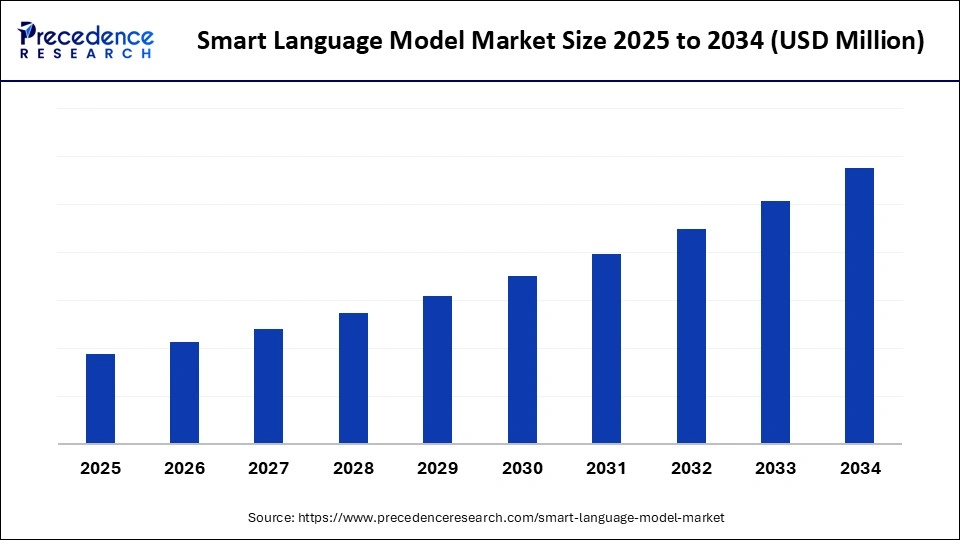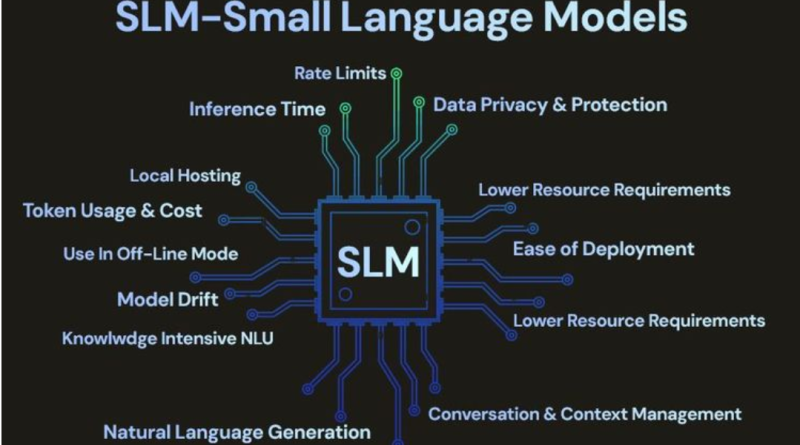Smart Language Model Market: Transforming the AI Landscape (2025–2034)
Why Smart Language Models Are Shaping the Future of AI
Smart Language Models (SLMs) are revolutionizing how machines interpret, generate, and engage with human language. These AI-powered systems—ranging from massive foundational models like GPT-4 and Claude to specialized task-specific language models—are driving innovation across industries, from healthcare and telecom to education and finance. As natural language processing (NLP) and multimodal learning become mainstream, the global smart language model market is poised for exponential growth.
This market is not only transforming how we interact with technology but also streamlining workflows, automating content creation, enhancing customer support, and enabling intelligent decision-making—all while minimizing human intervention.

Market Snapshot: Smart Language Model Market Size & Forecast (2025–2034)
-
Market CAGR: Substantial growth driven by NLP integration across verticals
-
Base Year: 2024
-
Forecast Period: 2025 to 2034
-
Dominating Region: North America
-
Fastest Growing Region: Asia Pacific
-
Leading Segment (Application): Customer Support & Virtual Assistants (29% share in 2024)
-
Top Deployment Model: Cloud-Based APIs (70% share in 2024)
-
Key Growth Driver: Advancements in AI and increasing demand for intelligent automation
Key Takeaways
-
North America held the largest market share (47%) in 2024 due to strong R&D, infrastructure, and tech leadership.
-
Asia Pacific is expected to be the fastest-growing region, fueled by digital transformation, mobile penetration, and government-led AI initiatives.
-
Foundation language models (e.g., GPT, Gemini, Claude) dominated with a 62% share, while task-specific SLMs are gaining momentum.
-
Customer support and virtual assistants lead applications, but content generation tools are growing at the fastest CAGR.
-
Cloud-based APIs remain the preferred deployment mode, while edge deployment is gaining traction for privacy and latency benefits.
-
IT & telecom lead by end-user verticals, followed by rapid growth in healthcare and life sciences.
-
Natural language understanding is foundational, while natural language generation is the fastest-growing functionality segment.
What Are Smart Language Models?
Smart Language Models are AI systems designed to understand, generate, and respond to human language using complex machine learning architectures—primarily deep learning and NLP techniques. Based on Transformer models and trained on vast datasets, they enable machines to perform human-like tasks such as answering questions, translating languages, creating content, and analyzing sentiment.
Key use cases include:
-
AI-powered chatbots and virtual assistants
-
Automated content generation (blogs, emails, scripts)
-
Language translation and localization
-
Legal document review and compliance checks
-
Clinical note generation in healthcare
-
Coding assistance and software development
Popular models include OpenAI’s GPT, Google’s Gemini, Anthropic’s Claude, Meta’s LLaMA, and emerging tools like xAI’s Grok and Stability AI’s open-source models.
What’s Driving the Growth of the Smart Language Model Market?
Technological Advancements
The integration of multimodal AI, which processes text, audio, images, and video, is reshaping model capabilities. SLMs are now capable of answering visual questions, interpreting voice input, or summarizing lengthy documents into actionable insights.
Few-shot and zero-shot learning allow these models to perform complex tasks with limited training data—reducing time, cost, and human effort.
Moreover, LoRA-based fine-tuning and prompt engineering are enabling businesses to customize large models for specific domains, improving performance and ROI.
Rise of Edge Computing
Smart models deployed at the edge (e.g., smartphones, IoT devices) provide fast, private, and cost-efficient language processing without relying on centralized servers. This shift not only reduces latency but also addresses concerns about data sovereignty and privacy.
Cross-Industry Adoption
Smart Language Models are finding use across sectors:
-
Healthcare: Medical transcription, diagnostics support, and patient interaction
-
Education: AI tutors, feedback tools, and automated grading
-
Finance: Sentiment analysis, risk modeling, and fraud detection
-
Retail: Personalized shopping experiences and voice commerce
-
Legal & Government: Contract analysis, legal research, and multilingual compliance tools
Market Challenges: What’s Holding Back Wider Adoption?
Ethical and Regulatory Risks
While these models offer powerful capabilities, they also raise concerns:
-
Data privacy violations due to unregulated data scraping
-
Biased outputs from non-diverse training data
-
Hallucinations and misinformation dissemination
-
Limited explainability for decisions made by black-box models
As AI regulation becomes a global priority, vendors will need to build transparent, fair, and responsible models.
Market Opportunities: Where’s the Untapped Potential?
Education and Research
Smart models are increasingly used by students, researchers, and academic institutions to summarize studies, assist with thesis writing, and explain complex topics in simple language.
Industry-Specific AI
The future lies in verticalized smart language models tailored for industries like finance, pharma, and engineering. These models offer domain-specific knowledge, lower hallucination rates, and better compliance—making them more useful than general-purpose tools.
Tool Integration & Workflow Automation
Combining SLMs with APIs, spreadsheets, CRM systems, and DevOps pipelines allows businesses to automate repetitive tasks, streamline operations, and unlock new productivity gains.
Smart Language Model Market Segmental Analysis:
Application Analysis
Top Segment: Customer Support & Virtual Assistants (29% in 2024)
These models offer 24/7 multilingual, omnichannel support, personalized recommendations, and automated issue resolution—redefining how businesses interact with customers.
Fastest-Growing Segment: Content Generation & Copywriting
Tools like ChatGPT, Jasper, and Copy.ai are empowering marketers, writers, and social media managers to scale up content creation for blogs, ads, product descriptions, and more.
Model Type Analysis:
Foundation Language Models Dominate (62% in 2024)
These models are general-purpose and trained on massive datasets, making them flexible, reusable, and easy to fine-tune.
Task-Specific SLMs Growing Rapidly
Smaller, efficient models fine-tuned for vertical use cases (e.g., legal summarization, code generation) offer high accuracy and lower compute costs—ideal for deployment in SMEs and regulated environments.
Deployment Mode Analysis:
Cloud-Based APIs Lead (70% in 2024)
These models are easily accessible, scalable, and ideal for enterprises looking to rapidly deploy without deep AI expertise. OpenAI, Google, Microsoft, and Amazon dominate here.
Edge Deployment to Expand Rapidly
Edge models offer fast, offline processing—ideal for sensitive use cases in finance, defense, and healthcare. They also minimize cloud costs and reduce environmental impact.
End-Use Industry Analysis:
IT & Telecom Leads (25% in 2024)
AI is being deployed for network diagnostics, customer support, and predictive maintenance. Virtual assistants help telecom providers reduce churn and improve engagement.
Healthcare & Life Sciences Rising Fast
From EMR summarization to diagnostics and drug discovery, SLMs are transforming healthcare workflows, reducing administrative burden, and improving clinical decision-making.
Functionality Analysis:
Natural Language Understanding (NLU) Dominates
NLU powers tools like chatbots, search engines, and intent recognition systems—enabling machines to interpret human input accurately.
Natural Language Generation (NLG) Growing Quickly
NLG drives personalized content creation, automated reporting, and dynamic response generation, making it critical in content-heavy sectors.
Also Read@ Artificial Intelligence in Healthcare Market to Transform Global Care Delivery
Regional Analysis: Smart Language Model Market by Geography
North America: Leading the Charge in Foundational AI Development
Market Share in 2024: ~47% (Largest regional share)
Key Drivers:
-
Advanced R&D ecosystem
-
Top AI vendors headquartered in the U.S.
-
Strong regulatory focus on responsible AI (e.g., Biden Administration’s Executive Order on AI)
-
High cloud adoption and enterprise readiness
Notable Example:
In July 2025, Microsoft began testing a “smart mode” in its Copilot platform, possibly launching alongside GPT-5 from OpenAI. This shows how North America continues to be the first mover in commercial AI applications and integrations.
Hotspots:
-
Silicon Valley (California) – OpenAI, Anthropic, xAI, Google DeepMind U.S. operations
-
Seattle – Microsoft, Amazon AWS AI
-
Toronto – Home to Cohere and strong academic backing via the Vector Institute
Asia Pacific: Fastest-Growing Market Fueled by Digital Acceleration
Growth Forecast: Highest CAGR through 2034
Key Drivers:
-
Explosive growth in internet and smartphone penetration
-
National AI strategies (e.g., India’s AI Mission, China’s AI roadmap)
-
Expanding manufacturing, fintech, and healthcare sectors
-
AI integration in public services and education
Notable Example:
In early 2025, Alibaba’s DAMO Academy launched an enhanced version of Tongyi Qianwen, a foundational model tailored for Chinese enterprises. Additionally, Baidu continued integrating its ERNIE models into everyday services like search and smart voice assistants.
Hotspots:
-
China – Strong push for AI self-reliance; Baidu, Alibaba, Huawei lead NLP research
-
India – Growing adoption in BFSI, e-governance, and education
-
Japan & South Korea – Focused on industrial AI applications and privacy-aware edge deployments
Europe: Regulation-Driven AI Market with Research Depth
Market Share: Moderate but growing steadily
Key Drivers:
-
Strong public funding for open-source models
-
Early adoption of the EU AI Act to ensure responsible AI usage
-
Focus on sovereign cloud and data privacy (GDPR)
-
Strategic focus on academic-industrial collaboration
Notable Example:
In July 2025, researchers from EPFL, ETH Zurich, and the Swiss National Supercomputing Center developed a new open-source large language model for public good. This is part of Europe’s effort to democratize AI development and reduce reliance on U.S.-based giants.
Hotspots:
-
Germany – Aleph Alpha, SAP AI Labs, Fraunhofer AI Institute
-
France – Mistral AI rapidly scaling multimodal open models
-
Switzerland – Key player in ethical AI and sustainable LLM development
Latin America: Emerging Region with Untapped Potential
Growth Forecast: Moderate CAGR with high long-term potential
Key Drivers:
-
Rapid digital transformation across SMEs
-
Government initiatives in digital literacy and AI inclusion
-
Expanding call center, BPO, and edtech sectors
Examples:
-
Brazil and Mexico are investing in NLP models for public health messaging and multilingual citizen services.
-
AI-powered chatbots are replacing traditional customer service in retail and telecom sectors.
Challenges:
-
Limited compute infrastructure
-
Need for localized datasets in Spanish and Portuguese
-
Dependency on cloud-based APIs from North American providers
Middle East & Africa: AI as a Catalyst for Transformation
Growth Status: Nascent but gaining momentum
Key Drivers:
-
Smart city and digital government programs (e.g., UAE’s National AI Strategy 2031)
-
Investments in cloud infrastructure and sovereign AI capabilities
-
Demand for Arabic and African language-based models
Examples:
-
UAE’s G42 group collaborates with international AI players to develop bilingual smart assistants.
-
South Africa and Kenya are deploying AI-powered tools in education and agricultural extension services.
Challenges:
-
Infrastructure gaps and limited regional training datasets
-
Brain drain and need for local AI talent development
Source@ https://www.precedenceresearch.com/smart-language-model-market
- Case Study: SABIC – Predictive Maintenance and AI-Driven Operational Excellence - August 19, 2025
- Case Study: BASF – AI-Driven Material Discovery - August 19, 2025
- Artificial Intelligence in Chemicals Market to Surpass USD 28 Billion by 2034 as Digital Twins and Sustainability Drive Transformation - August 19, 2025

